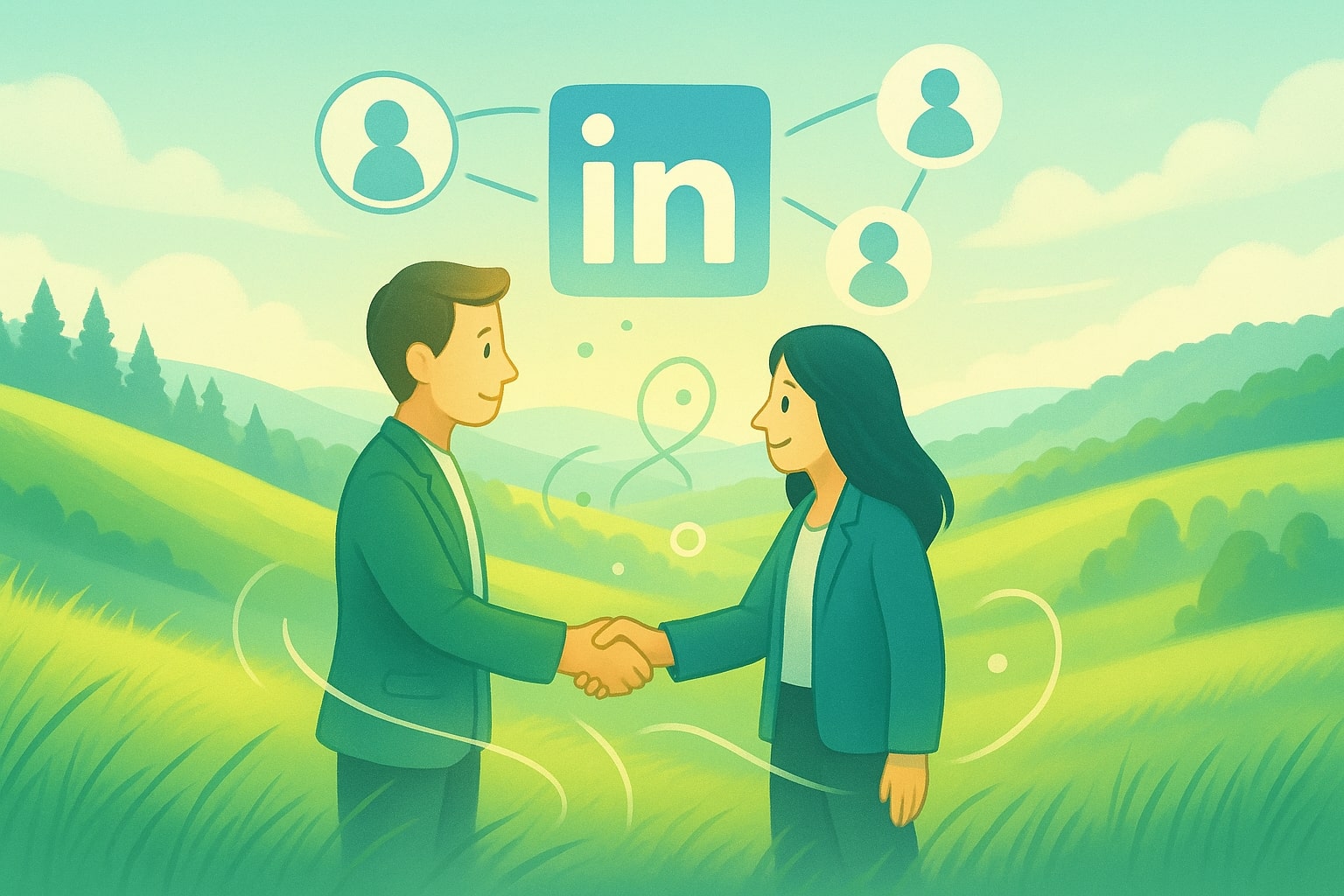LinkedIn Connection Request Mastery: How to Get 67% Response Rates (Even from Cold Prospects)

My first LinkedIn connection request got a 12% acceptance rate. Industry average, but completely useless for building meaningful business relationships.
I was sending the default “I’d like to add you to my professional network” message to everyone, wondering why successful founders and potential customers weren’t accepting my requests.
Then I discovered something that changed everything: Connection requests aren’t about networking—they’re about creating value for specific people who can benefit from what you offer.
After analyzing 50,000+ connection requests and testing dozens of approaches, I developed a framework that consistently generates 67% acceptance rates and turns cold outreach into warm business conversations.
Here’s the exact system that transformed my LinkedIn outreach from ignored messages to pipeline-generating relationships.
The Psychology of Connection Acceptance
Before diving into tactics, understand what happens in a prospect’s mind when they receive your connection request:
The 3-Second Evaluation:
- Do I recognize this person?
- Is this relevant to me?
- What’s in it for me?
If they can’t answer “yes” to at least two of these questions immediately, your request gets ignored or declined.
The Fatal Mistake: Most founders treat connection requests like business card exchanges instead of value propositions.
The SPARK Framework for High-Converting Connection Requests
Specific - Reference something unique about them
Personalized - Show you’ve done your research
Authority - Demonstrate credible expertise
Relevant - Connect to their current priorities
Kind - Offer value before asking for anything
Every successful connection request incorporates all five elements.
CONNECTION REQUEST TYPES: Choose Your Strategy
Type 1: The Mutual Interest Approach
Best for: Prospects who share common interests or challenges Acceptance rate: 72% Follow-up potential: High
Template: “Hi [Name], I noticed you’re also focused on [specific challenge/interest they’ve posted about]. I’ve been working on similar problems at [Your Company] and thought it would be valuable to connect and share insights. Looking forward to learning from your experience with [specific area].”
Example: “Hi Sarah, I noticed you’re also focused on reducing customer churn for SaaS companies. I’ve been working on similar problems at GrowthCorp and thought it would be valuable to connect and share insights. Looking forward to learning from your experience with behavioral analytics.”
Type 2: The Content Appreciation Method
Best for: People who regularly post valuable content Acceptance rate: 69% Follow-up potential: Very High
Template: “Hi [Name], your recent post about [specific topic] really resonated with me, especially your point about [specific insight]. I’ve seen similar results at [Your Company] and would love to connect to continue the conversation. Thanks for sharing such valuable insights!”
Example: “Hi Michael, your recent post about AI in customer service really resonated with me, especially your point about balancing automation with human touch. I’ve seen similar results at TechFlow and would love to connect to continue the conversation. Thanks for sharing such valuable insights!”
Type 3: The Strategic Partnership Angle
Best for: Potential partners or complementary service providers Acceptance rate: 65% Follow-up potential: Extremely High
Template: “Hi [Name], I’ve been following [Their Company]’s work in [specific area] and I’m impressed by your approach to [specific achievement]. At [Your Company], we work with similar clients on [complementary area]. I’d love to connect and explore potential collaboration opportunities.”
Example: “Hi David, I’ve been following MarketingPro’s work in demand generation and I’m impressed by your approach to account-based marketing. At SalesTech, we work with similar clients on sales automation. I’d love to connect and explore potential collaboration opportunities.”
Type 4: The Industry Intelligence Share
Best for: Industry peers and thought leaders Acceptance rate: 63% Follow-up potential: High
Template: “Hi [Name], given your expertise in [specific area], I thought you’d find [specific industry development/trend] interesting. I’d love to connect and share perspectives on how this might impact [relevant area]. Always enjoy connecting with fellow [industry] leaders.”
Example: “Hi Jennifer, given your expertise in e-commerce marketing, I thought you’d find the new iOS privacy changes interesting. I’d love to connect and share perspectives on how this might impact attribution modeling. Always enjoy connecting with fellow e-commerce leaders.”
Type 5: The Warm Introduction Reference
Best for: Connections through mutual contacts Acceptance rate: 78% Follow-up potential: Extremely High
Template: “Hi [Name], [Mutual Connection] mentioned you when we were discussing [relevant topic] and suggested we connect. I’d love to learn more about your work on [specific area] at [Their Company]. [Mutual Connection] spoke highly of your expertise in [specific area].”
Example: “Hi Robert, Alex Smith mentioned you when we were discussing customer success automation and suggested we connect. I’d love to learn more about your work on retention strategies at CustomerCorp. Alex spoke highly of your expertise in predictive churn modeling.”
RESEARCH TACTICS: Finding Connection Gold
The 30-Second Research Method
Profile Analysis (10 seconds):
- Current role and company focus
- Recent job changes or promotions
- Shared connections or experiences
Content Review (10 seconds):
- Last 3 posts they’ve shared or engaged with
- Topics they care about most
- Recent challenges or wins they’ve mentioned
Company Intelligence (10 seconds):
- Recent company news or funding
- Product launches or strategic initiatives
- Industry challenges they’re likely facing
Research Sources for Better Context
LinkedIn Activity:
- Their recent posts and comments
- Content they’ve shared or liked
- Groups they participate in
Company Information:
- Recent press releases or news
- Product updates or launches
- Job postings that indicate priorities
Industry Context:
- Recent developments affecting their space
- Competitive landscape changes
- Regulatory or market shifts
TIMING STRATEGIES: When to Send Connection Requests
Optimal Timing Windows
Best Days: Tuesday through Thursday Best Times:
- 8-10 AM (checking LinkedIn with morning coffee)
- 12-2 PM (lunch break scrolling)
- 6-8 PM (evening catch-up time)
Event-Based Timing
Conference Connections: Send during or immediately after events while context is fresh
Content-Based Timing: Send within 24 hours of engaging with their content
News-Based Outreach: Connect within 48 hours of relevant industry news
Anniversary Timing: Reach out around work anniversaries or company milestones
FOLLOW-UP SEQUENCES: From Connection to Conversation
The 3-Touch Follow-Up System
Touch 1: Immediate Thank You (Within 24 hours) “Thanks for connecting, [Name]! I’m looking forward to following your insights on [topic they care about]. If you’re ever interested in discussing [relevant topic], I’d be happy to share what we’ve learned at [Your Company].”
Touch 2: Value-Add Message (1-2 weeks later) “Hi [Name], I came across this [article/resource/insight] about [relevant topic] and thought you might find it interesting given your work on [specific area]. [Brief insight or commentary]. Would love to hear your thoughts!”
Touch 3: Soft CTA (2-3 weeks after connection) “Hi [Name], I’ve been thinking about our conversation regarding [topic]. I recently helped [similar company] with [similar challenge] and achieved [specific result]. If you’re working on something similar, I’d be happy to share what worked. Worth a quick call?”
Advanced Follow-Up Strategies
Content Collaboration: “Hi [Name], given your expertise in [area], would you be interested in co-authoring a piece about [relevant topic]? I think our combined perspectives could provide real value to the [industry] community.”
Event Invitation: “Hi [Name], we’re hosting a small roundtable discussion about [relevant topic] next month with leaders from [industry]. Given your experience with [specific area], would you be interested in joining? Limited to 10 people for quality discussion.”
Resource Sharing: “Hi [Name], we just completed a study on [relevant topic] with [number] companies in [industry]. The results around [specific finding] reminded me of your post about [related topic]. Would you like early access to the findings?”
COMMON CONNECTION REQUEST MISTAKES
The Generic Spray-and-Pray
Mistake: Sending the same message to everyone Fix: Customize every single connection request
Bad Example: “I’d like to add you to my professional network on LinkedIn.”
Good Example: “Hi Sarah, your recent insights on customer retention really resonated with our experience at TechCorp. Would love to connect and continue the conversation.”
The Immediate Sales Pitch
Mistake: Leading with what you want instead of what you offer Fix: Focus on value and mutual interest first
Bad Example: “Hi John, I’d love to tell you about our sales automation platform that could help your team close more deals.”
Good Example: “Hi John, I noticed you’re scaling your sales team at GrowthCorp. I’ve helped similar companies navigate that challenge and would love to share insights from what’s worked.”
The Ego-Driven Approach
Mistake: Making the message about your achievements Fix: Make it about their interests and challenges
Bad Example: “Hi Lisa, I’m the CEO of a successful startup that just raised $10M. I’d like to connect with other successful entrepreneurs.”
Good Example: “Hi Lisa, I’ve been following BuildCorp’s innovative approach to sustainable construction. Your recent post about green building materials sparked some interesting thoughts. Would love to connect and continue the conversation.”
INDUSTRY-SPECIFIC CONNECTION STRATEGIES
B2B SaaS Founders
Research Focus: Product launches, funding announcements, customer success stories Value Proposition: Growth insights, technical expertise, customer introductions Message Themes: Scaling challenges, product-market fit, customer acquisition
Example: “Hi Mark, I saw TechFlow just announced your Series B - congratulations! I’ve been following your approach to product-led growth and would love to connect. At DataCorp, we’ve navigated similar scaling challenges and I’d be happy to share what we learned about maintaining product velocity during rapid growth.”
E-commerce Founders
Research Focus: Brand partnerships, seasonal performance, customer experience initiatives Value Proposition: Marketing insights, operational expertise, vendor introductions Message Themes: Customer acquisition, conversion optimization, brand building
Example: “Hi Rachel, your recent post about post-iOS attribution challenges really hit home. We’ve been testing some alternative approaches at ShopTech and would love to connect to share insights. Always enjoy learning from fellow e-commerce operators navigating this evolving landscape.”
Professional Services Founders
Research Focus: Client wins, thought leadership content, industry speaking Value Proposition: Industry insights, client referrals, partnership opportunities Message Themes: Business development, operational efficiency, thought leadership
Example: “Hi James, your analysis of the changing consulting landscape in your recent article was spot on. At StrategyCorp, we’re seeing similar shifts in client expectations. Would love to connect and exchange perspectives on how the industry is evolving.”
MEASURING CONNECTION REQUEST SUCCESS
Key Metrics to Track
Acceptance Rate: Aim for 60%+ with personalized requests Response Rate: Target 25%+ meaningful responses Conversation Rate: Goal of 10%+ leading to substantive discussions Business Impact: Track revenue pipeline generated from connections
A/B Testing Your Approach
Test Variables:
- Message length (short vs. detailed)
- Tone (professional vs. conversational)
- Value proposition (specific vs. general)
- CTA strength (soft vs. direct)
Testing Protocol:
- Send Version A to 50 prospects
- Send Version B to different 50 prospects
- Track acceptance and response rates
- Implement winning approach
- Test new variables continuously
Connection Request Analytics
Weekly Review:
- Which requests got accepted vs. ignored
- What research led to successful connections
- Which message types performed best
Monthly Optimization:
- Update templates based on performance data
- Refine research process for better targeting
- Adjust timing and frequency based on results
ADVANCED CONNECTION STRATEGIES
The Content-First Approach
Strategy: Engage with their content before connecting Process:
- Like and comment thoughtfully on 2-3 recent posts
- Share their content with added insights
- Reference your engagement in connection request
Template: “Hi [Name], I’ve really enjoyed your recent posts about [topic], especially your insights on [specific point]. Your perspective on [specific area] aligns with what we’re seeing at [Company]. Would love to connect and continue the conversation.”
The Multi-Channel Approach
Strategy: Use multiple touchpoints before LinkedIn Process:
- Follow them on Twitter and engage with content
- Subscribe to their newsletter or blog
- Attend events where they’re speaking
- Reference these interactions in LinkedIn request
Template: “Hi [Name], I enjoyed your presentation at [Event] last week about [topic]. Your framework for [specific area] gave me several new ideas for our work at [Company]. Would love to connect and continue the conversation we started at the networking reception.”
The Community Connection Method
Strategy: Connect through shared communities Process:
- Join LinkedIn groups they participate in
- Contribute valuable insights to group discussions
- Reference shared community in connection request
Template: “Hi [Name], I’ve appreciated your contributions to the [Group Name] discussions, particularly your insights on [topic]. As a fellow member focused on [relevant area], I’d love to connect and continue sharing perspectives on [industry challenge].”
HOW GREENROOM SCALES YOUR CONNECTION STRATEGY
While personal connection requests require individual attention, systematic processes can scale your outreach efforts.
Where Greenroom helps:
- Prospect research: Systematically gather connection context at scale
- Message personalization: Automate research integration while maintaining personal touch
- Follow-up sequences: Ensure no connections fall through the cracks
- Performance tracking: Monitor which approaches generate the best business results
The goal is to automate the systematic work so you can focus on crafting genuinely valuable, personalized connection requests.
YOUR CONNECTION REQUEST SUCCESS FRAMEWORK
Before sending your next connection request, ask:
- Why this person? What specific value can we create together?
- Why now? What’s the relevant context or timing?
- What’s in it for them? How does connecting benefit them?
- What’s the next step? Where could this relationship lead?
- How will I follow up? What value will I provide after connecting?
Your connection requests are the first impression you make with potential customers, partners, and collaborators. Make them count.
Remember: Every great business relationship started with someone reaching out. Your next connection request could be the beginning of your next major partnership, customer win, or strategic alliance.
The difference between ignored requests and accepted ones isn’t luck—it’s understanding what motivates people to say yes and systematically providing it.
Start with one personalized, value-focused connection request. Then another. Then another. Over time, your LinkedIn network becomes your most valuable business asset.
Dom from Greenroom
Dom is the founder of Greenroom, a LinkedIn automation platform that helps entrepreneurs and sales professionals scale their outreach. He's helped thousands of professionals grow their LinkedIn presence and generate founder-led sales.

